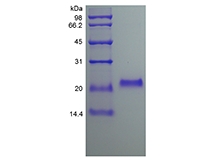| Official Full Name |
Recombinant Human Osteoprotegerin (rHuOPG) |
| Squence |
 |
| Amino Acid Sequence |
ETFPPKYLHY DEETSHQLLC DKCPPGTYLK QHCTAKWKTV CAPCPDHYYT DSWHTSDECL YCSPVCKELQ YVKQECNRTH NRVCECKEGR YLEIEFCLKH RSCPPGFGVV QAGTPERNTV CKRCPDGFFS NETSSKAPCR KHTNCSVFGL LLTQKGNATH DNICSGNSES TQK |
| Synonyms |
TNFRSF11B, Osteoclastogenesis Inhibitory Factor, Tumor Necrosis Factor Receptor Superfamily Member 11B |
| Accession Number |
O00300 |
| GeneID |
4982 |
| Summary |
Osteoprotegerin (OPG), also named osteoclastogenesis inhibitory factor (OCIF), and tumor necrosis factor receptor superfamily member 11B (TNFRSF11B), is a TNFRSF11B-encoded protein in humans. OPG is a 401 a.a. basic glycoprotein which comprises 7 structural domains. It is either a 60 kDa monomer or a 120 kDa dimer linked by disulfide bridges. OPG acts as a decoy receptor for the receptor activator of nuclear factor kappa B ligand (RANKL) and inhibits the activation of osteoclasts and promotes osteoclast apoptosis in vitro and may also play a role in preventing arterial calcification. OPG has been applied to decrease bone resorption in women with postmenopausal osteoporosis and in patients with lytic bone metastases. Mature human OPG shares 86 %, 87 %, 92 %, 92 % and 88 % amino acid sequence identity with mouse, rat, equine, canine and bovine OPG, respectively. |
| Source |
Escherichia coli. |
| Molecular Weight |
Approximately 19.7 kDa, a single non-glycosylated polypeptide chain containing 173 amino acids. |
| Biological Activity |
Fully biologically active when compared to standard. The ED50 as determined by neutralizing the stimulation of U937 cells is less than 10 ng/ml, corresponding to a specific activity of > 1.0 × 105 IU/mg in the presence of 10 ng/mL soluble rHuRANKL (sRANKL). |
| Appearance |
Sterile filtered white lyophilized (freeze-dried) powder. |
| Formulation |
Lyophilized from a 0.2 um filtered concentrated solution in 20 mM PB,150 mM NaCl, pH 6.0. |
| Endotoxin |
Less than 1 EU/ug of rHuOPG as determined by LAL method. |
| Reconstitution |
We recommend that this vial be briefly centrifuged prior to opening to bring the contents to the bottom. Reconstitute in sterile distilled water or aqueous buffer containing 0.1 % BSA to a concentration of 0.1-1.0 mg/ml. Stock solutions should be apportioned into working aliquots and stored at ≤ -20°C. Further dilutions should be made in appropriate buffered solutions. |
| Stability and Storage |
Use a manual defrost freezer and avoid repeated freeze-thaw cycles.- 12 months from date of receipt, -20 to -70 °C as supplied.- 1 month, 2 to 8 °C under sterile conditions after reconstitution.- 3 months, -20 to -70 °C under sterile conditions after reconstitution. |
| References |
|
| SDS-PAGE |
 |
| Safety Data Sheet (SDS) Download |
Click to download |
| Technical Data Sheet (TDS) Download |
Click to download |



